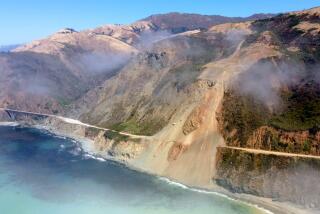Caltrans Blames Ramp Design, Work
- Share via
Designers and the prime contractor are responsible for construction flaws that might delay the opening of a $12-million ramp linking the San Diego and Costa Mesa freeways, Caltrans officials said Wednesday.
The state transportation department has told CH2M Hill, an international engineering firm, and C.C. Myers Inc., a construction company based in Rancho Cordova, that they must repair the towering structure before it can be opened for traffic. The ramp is a two-way connector designed to carry carpool-lane traffic leaving the southbound 55 and the northbound 405.
“We have identified apparent design and construction deficiencies,” said Pam Gorniak, a Caltrans spokeswoman, in a prepared statement. “We have instructed the responsible parties to submit remedial plans that address their deficiencies.”
CH2M Hill officials could not be reached for comment Wednesday. C.C. Myers Inc. referred all questions to Caltrans. Gorniak said both companies disagree with the department’s conclusions but would not elaborate. No lawsuits have been filed.
The carpool connector is part of a $125-million project designed to relieve congestion at the busy interchange of the San Diego and Costa Mesa freeways. The improvements are a collaborative effort between Caltrans and the Orange County Transportation Authority.
Work was halted on the towering ramp two months ago when construction crews found that concrete was cracking and falling off the supporting walls that run the length of the connector. The unusual condition is known as spalling.
Investigators said the condition affects about 5% of the concrete that covers the bridge’s reinforcing steel along the inside of the roadway’s curve. Although spalling has been found in dozens of spots, the connector is in no danger of collapsing and no concrete is falling off the structure.
Rick Grebner, an OCTA engineer and project manager, said the concrete might have been dislodged within the ramp when construction crews using hydraulic machinery applied tension to reinforcing cables that run through it. The tension, which is designed to strengthen the structure, caused the cables to move unexpectedly, popping off the cement.
Repair work might involve as little as repouring sections of concrete along the half-mile ramp or, in the worst-case scenario, rebuilding the elevated road bed, except for the columns and foundations.
The connector was scheduled to go into service next April. But officials said the defects could postpone the opening until the end of 2003.
Gorniak said that as soon as the spalling was discovered, Caltrans notified CH2M Hill and C.C. Myers. A subsequent evaluation by the department, she said, indicated that the companies were responsible.
Both firms have until the end of the year to come up with plans to repair the ramp. Ken Smart, OCTA’s general counsel, said the contracts for the interchange project hold designers, construction companies and management companies responsible for the services and products they provide.
“Right now we are letting the engineers and the others involved in the construction do their thing,” Smart said. “We need to come up with a remedy. We need to get things fixed and the road opened for the traveling public.”
More to Read
Sign up for Essential California
The most important California stories and recommendations in your inbox every morning.
You may occasionally receive promotional content from the Los Angeles Times.














